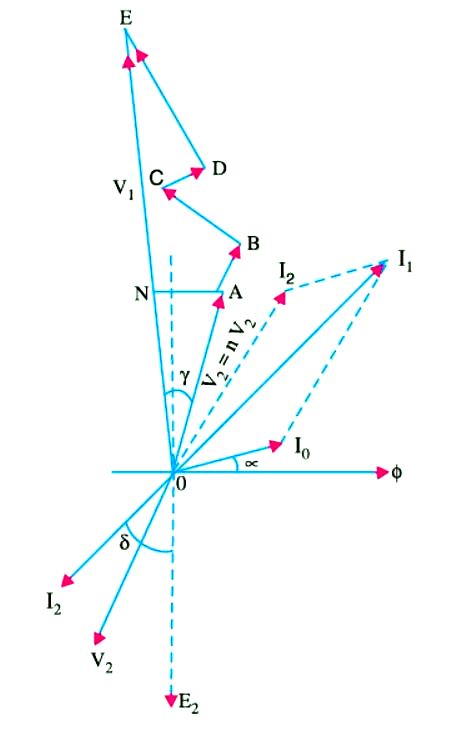Potential Transformers
Potential transformers are extremely accurate-ratio stepdown transformers and are used in conjunction with standard low-range voltmeters (100-120 V) whose deflection when divided by transformation ratio, gives the true voltage on the primary or high voltage side. In general, they are of the shell type and do not differ much from the ordinary two-winding transformers except that their power rating is extremely small. Sine their secondary windings are required to operate instruments or relays or pilot lights, their ratings are usually of 40 to 100W. For safety, the secondary is completely insulated from the high voltage primary and is, in addition, grounded for affording protection to the operator. Figure (A) shows the connection of such a transformer.

Ratio and Phase-angle Errors Potential Transformers:
In the case of a potential transformers, we are interested in the ratio of the primary to the secondary terminal voltage and in the phase angle γ between the primary and reversed secondary terminal voltage V2′ .
The general theory of voltage transformer is the same as for the power transformers except that, as the current in the secondary burden is very small, the total primary current I1 is not much greater than I0.
In the phasor diagram of Figure (B) & (C), vectors AB, BC, CD and DE represent small voltage drops due to resistances and reactance of the transformer winding (they have been exaggerated for the sake of clarity). Since the drops as well as the phase angle γ are small, the top portion of diagram (Figure B) can be drawn with negligible loss of accuracy as in Figure (C) where V2′ vector has been drawn parallel to the vector for V1.
AdBlock-2

In these diagrams, V2′ is the secondary terminal voltage as referred to primary assuming transformation without voltage drops. All actual voltage drops have been referred to the primary. Vector AB represents total resistive drop as referred to primary i.e. I2′ R01. Similarly, BC represents total reactive drop as referred to primary i.e. I2′ X01.
In a voltage transformer, the relatively large no-load current produces appreciable resistive drops which have been represented by vectors CD and DE respectively. Their values are I0R1 and I0X1 respectively.

Ratio Error of Potential Transformers
In the following theory, n would be taken to represent the ratio of primary turns to secondary turns (Article Instrument Transformer). Further, it would be assumed, as before, that n equals the nominal transformation ratio i.e. n = kn. In other words, it would be assumed that V1/V2 = n, although, actually, V1/V2′ = n.

where Iω and Iμ are the iron-loss and magnetising components of the no-load primary current I0.
Phase Error (γ) of Potential Transformers
To a very close approximation, value of γ is given by γ = AN/OA ————-—in radian
Now, OA ≅ OE provided ratio error is neglected. In that case,

The negative sign has been given because reversed secondary voltage i.e. V2′ lags behind V1.
Read article – Units of Resistivity
Visit NCERTplanet.com for NCERT solutions and Textbook downloads




